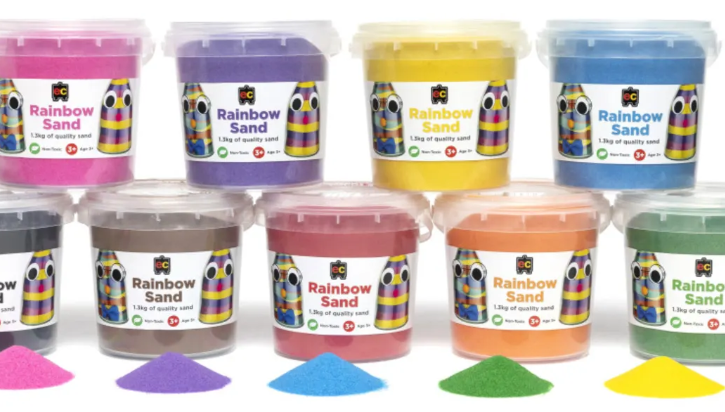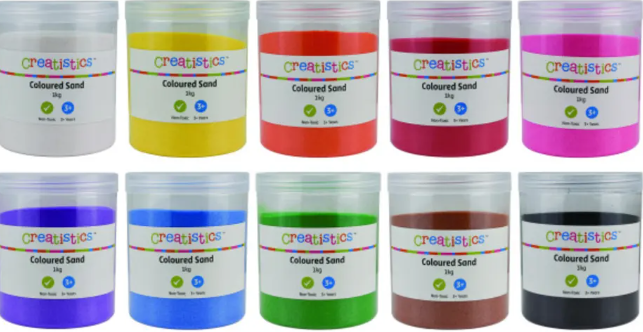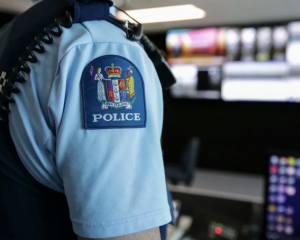
What is the product that was recalled?
The sand is brightly coloured and used for play, craft and classroom activities. The recalled products are:
- Creatistics Coloured Sand
- Educational Colours Rainbow Sand
The recall widened on Saturday, 15 November, to include multiple Kmart Magic Sand products:
- 14-piece Sandcastle Building Set
- Blue Magic Sand
- Green Magic Sand
- Pink Magic Sand
Tremolite - a naturally occurring asbestos - had been found in samples during lab testing. Asbestos contamination had been found in similar products in Australia.
How dangerous is tremolite asbestos?
Inhalation of asbestos fibres is associated with an increased incidence in a number of respiratory diseases, including asbestosis, mesothelioma, pleural and lung cancers, ABC Australia reported.
MBIE said while testing of New Zealand product is ongoing, as a precautionary measure, the company Educational Colours has issued a recall notice.
"Asbestos is a serious health hazard and we are working with Health New Zealand Te Whatu Ora, the Ministry of Education and WorkSafe to provide guidance for consumers and educational facilities which may have bought these products."
What shops stock the sand?
The sand was sold at
- Paper Plus
- Hobby Land
- NZ School Shop
- Office Products Depot
- Discount Office
- Acquire
It was also sold at Qizzle, Modern Teaching Aids, Creative Classrooms Ltd and ACME Supplies.
MBIE said it may have also been sold online.
How long has it been on shelves?
"At this stage we do not have enough information to quantify how widespread the use of the product is in schools and early learning services," Ministry of Education head of operations and integration Sean Teddy said on Thursday.
How is it being handled?
The Ministry of Business Innovation and Employment (MBIE) said people needed to stop using the products immediately.
"We urge anyone who has bought these products, either for personal use or potential use in a school or other setting to act immediately," said Ian Caplin, MBIE product safety spokesperson.
"Stop using the sand, contain it, secure it in a safe place and arrange for safe disposal through licensed professionals, a list of these is available on the WorkSafe website."

"It's not a question of hoovering it up and chucking it in a waste bin, call an expert.,"
RNZ had been in touch with a number of asbestos removal firms who said they had been notified of the product by WorkSafe, and were awaiting further information before formulating plans to address potential contamination.
What should parents do?
- Stop using it immediately
- Place the sand in a sealed container and store it securely away from people.
- Do not dispose of it in general waste. WorkSafe strongly recommends engaging a Class A licensed asbestos removalist for safe disposal. A list of licensed removalists can be found on the WorkSafe website.
Once secure, it encourages people to reach out to the supplier to organise a refund under the Consumer Guarantees Act.
What should schools and ECEs do?
- If the product is in a sealed container move it to a secure location away from people.
- If the sand is currently being used in your facility, please instruct everyone to leave the area, block it off and make sure it is not accessible.
- Do not vacuum or sweep floors where there is sand, or attempt to clean it up.
- Contact a licensed asbestos assessor or removalist for immediate advice and support on your specific situation. Details of Class A licensed removalists are available in the Asbestos Removal Licence Holders Register.
- Do not return to the affected area until the extent of contamination is established, and after the area is remediated by an expert.
- If individuals are currently using the sand, they should put it down and relocate to a sand-free, well-ventilated area.
- If an educational facility has identified that the sand has been used at their facility, they should notify Ministry of Education that the sand has been used on site, and detail the actions that have been taken so far.
Which schools have closed?
The Ministry of Education has been fielding a rapidly-growing number of calls from schools and ECEs, with more than 120 facilities now reporting they have used one of the recalled products.
At least seven centres have closed classrooms so licensed asbestos specialists can assess potential contamination. More are likely as checks continue.
- Burnside Primary School has closed
- Clearview Primary has closed
- Waitaha School closed Monday as a precaution
- Rolleston's Clearview Primary closed Monday, Tuesday and possibly Wednesday.
- Gilberthorpe School in Christchurch closed Monday and Tuesday while spaces are tested.
- Kapakapanui School in Waikanae relocated six classes while testing was carried out.
- Waterlea Primary School in Auckland relocated two classrooms.
- Two Auckland kindergartens remain closed












